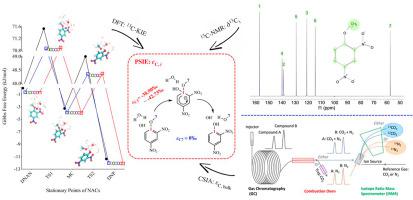Chemosphere ( IF 8.8 ) Pub Date : 2021-05-01 , DOI: 10.1016/j.chemosphere.2021.130625 Chunlei Wang 1 , Linnea J Heraty 1 , Adam F Wallace 1 , Changjie Liu 2 , Xiaoqiang Li 2 , Gregory P McGovern 3 , Juske Horita 2 , Mark E Fuller 4 , Paul B Hatzinger 4 , Neil C Sturchio 1

|
Compound-specific isotope analysis (CSIA), position-specific isotope analysis (PSIA), and computational modeling (e.g., quantum mechanical models; reactive-transport models) are increasingly being used to monitor and predict biotic and abiotic transformations of organic contaminants in the field. However, identifying the isotope effect(s) associated with a specific transformation remains challenging in many cases. Here, we describe and interpret the position-specific isotope effects of C and N associated with a SN2Ar reaction mechanism by a combination of CSIA and PSIA using quantitative 13C nuclear magnetic resonance spectrometry, and density-functional theory, using 2,4-dinitroanisole (DNAN) as a model compound. The position-specific 13C enrichment factor of O–C1 bond at the methoxy group attachment site (εC1) was found to be approximately -41‰, a diagnostic value for transformation of DNAN to its reaction products 2,4-dinitrophenol and methanol. Theoretical kinetic isotope effects calculated for DNAN isotopologues agreed well with the position-specific isotope effects measured by CSIA and PSIA. This combination of measurements and theoretical predictions demonstrates a useful tool for evaluating degradation efficiencies and/or mechanisms of organic contaminants and may promote new and improved applications of isotope analysis in laboratory and field investigations.
中文翻译:

通过化合物特异性同位素分析,13 C NMR和密度泛函理论解决了2,4-二硝基苯甲醚碱水解过程中的位置特异性同位素效应
化合物特异性同位素分析(CSIA),位置特异性同位素分析(PSIA)和计算模型(例如,量子力学模型;反应性运输模型)正越来越多地用于监测和预测有机污染物在生物体内的生物和非生物转化。场地。然而,在许多情况下,鉴定与特定转化相关的同位素效应仍然具有挑战性。在这里,我们通过定量13 C核磁共振谱法结合CSIA和PSIA ,以及使用2,4的密度泛函理论,描述和解释与S N 2Ar反应机理相关的C和N的特定位置同位素效应-二硝基苯甲醚(DNAN)作为模型化合物。特定位置13-O-C的Ç富集因子1个在甲氧基附着位点(键ε C1)被发现是大约-41‰,用于DNAN转化到它的反应产物2,4-二硝基苯酚和甲醇的诊断价值。为DNAN同位素分子计算的理论动力学同位素效应与CSIA和PSIA测量的位置特定同位素效应非常吻合。测量与理论预测的这种结合展示了一种评估降解效率和/或有机污染物机理的有用工具,并可促进同位素分析在实验室和现场调查中的新的和改进的应用。


























 京公网安备 11010802027423号
京公网安备 11010802027423号